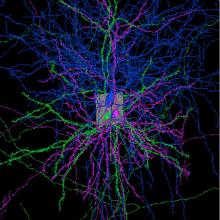Upcoming Events!
Past Events


Come eat snacks while making a craft and some new friends - we will provide perler beads and...
Come eat snacks while making a craft and some new friends - we will provide perler beads and embroidery materials but feel free to bring your own project of choice!



Abstract: During development, the central nervous system establishes precise connections with the...
Abstract: During development, the central nervous system establishes precise connections with the body to coordinate organ function. A crucial component of communication between the brain and body is the vagus nerve (cranial nerve X), which innervates multiple organ systems including the heart, lungs and digestive tract to regulate blood pressure, heart rate, respiration and digestion. Despite this important role, the molecular mechanisms guiding the vagus nerve to these organ targets during development remain unknown. We have developed the zebrafish embryo as a powerful model for interrogating vagus nerve development, taking advantage of its optical clarity and genetic accessibility. Using a novel photoconversion-based retrograde axon tracing approach we show that vagal motor neurons (mXns) that project to different organs (e.g. gallbladder, stomach, intestines) are spatially segregated within the hindbrain vagus nucleus. We hypothesize that these distinct mXn "target groups" have distinct molecular identities that guide axon targeting. To test this hypothesis, we have generated a developmental scRNAseq atlas focused on cranial motor neurons and have validated the spatially restricted expression of transcription factors and cell-surface molecules within the vagus motor nucleus. We have generated genetic tools to correlate gene expression with target groups, and performing a reverse mutagenesis screen to test the role of these candidates in topographic map formation, revealing preliminary mXn identity phenotypes. We have also observed that mXn axons contact specific subsets of enteric neurons (ENS) during motor axon pathfinding and have begun testing the role of these contacts in guiding topographic motor targeting.


Synopsis: My lab studies the circuit mechanisms that enable oxytocin (OXT)-producing neurons in the...
Synopsis: My lab studies the circuit mechanisms that enable oxytocin (OXT)-producing neurons in the vertebrate hypothalamus to control diverse behaviors. Working in larval zebrafish, we have found that OXT neuron activity elicited by noxious stimuli helps drive the acute, defensive response to physical threats through temporally sustained but spatially precise neuropeptide release within a brainstem premotor network. A parallel project demonstrates that OXT plays an evolutionarily conserved role in affiliative social behavior and socially-reinforced learning in the miniature fish, Danionella cerebrum. In this talk I'll discuss both those stories and their implications for an emerging picture of OXT's integrated physiological and behavioral roles.

Neural manifolds are a language for describing the structure of population activity in neural...
Neural manifolds are a language for describing the structure of population activity in neural populations, which is intrinsically shaped by the structure of the information the population encodes. Tools from the mathematical field of algebraic topology allow us to detect and characterize this intrinsic structure within individual neural populations without reference to external correlates. However, as experimental tools increasingly allow us to study multiple brain regions at once, it has become possible to ask how such structured information flows and transforms as it moves through the brain. As these topological tools do not rely on prior knowledge or hypotheses about what is encoded, they are ideally suited to frame and answer such questions. In this talk, we will discuss recent work developing computational tools for studying how structure in neural manifolds align (or fails to), and forthcoming work on how we can use these tools to study learning in biological neural systems. No prior understanding of topology or topological methods in neuroscience will be assumed.

Abstract: Neuroplasticity is an important feature of respiratory control and critical for life, as...
Abstract: Neuroplasticity is an important feature of respiratory control and critical for life, as this allows for adjustments to breathing to fit our metabolic needs across development, disease, injury, and aging. Nicotine is a highly addictive recreational drug that modulates neuronal excitability and plasticity, and the impact of in utero nicotine exposure on the development and function of central networks that control breathing have been extensively studied. Conversely, despite the widespread use of tobacco and nicotine products, we know little about how chronic nicotine exposure impacts breathing control in adulthood. This seminar will highlight some of the ways the Wollman lab studies nicotine-mediated plasticity of respiratory control by giving an overview of past and current research projects including 1) work in neonatal rats showing that in utero nicotine exposure modulates fast-synaptic transmission, indicating a potential mechanism for Sudden Infant Death Syndrome, and 2) Dr. Wollman’s current NIH funded research, which is the first to show the detrimental effects of acute nicotine withdrawal on respiratory chemoreflex control in adult rats.
